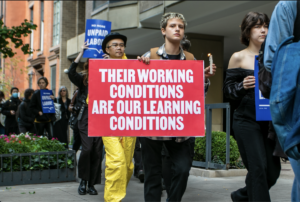The Last Picture Show
Independent theaters and films are struggling to survive the transition to digital cinema.
By Thomas Hedges, Center for Study of Responsive Law
In 1975, Universal Pictures launched the first nationwide ad campaign for its new film, “Jaws.” Universal avoided marketing its film regionally, as other major studios had been doing. Instead, it organized one major ad campaign, released the film nationally on a single date and raked in most of its profits that weekend, before anyone could say whether the film was worth the money.
Today, all major studios do nationwide releases. After “Jaws,” studios got rid of their regional marketing offices and consolidated them into national headquarters, where films would be distributed to thousands of theaters across the country.
Theaters, in turn, consolidated their spaces. Independent theaters were swallowed up by regional chains, which were then swallowed up by national chains, which were then swallowed up by multinational chains. It became more profitable to have one 20-screen complex rather than 10 two-screen theaters, especially because most people went to see the same few films.
During merger mania, small, independent theaters have struggled to survive as movie studios and multiplex chains spend more and more money promoting conventional cinema.
But now, independent theaters are facing a new threat: the shift from 35mm film to digital projection equipment, which reduces the fees of printing and shipping 40-pound film reels for studios but costs exhibitors from $60,000 to $80,000 to install. The price tag is one that many small-theater owners cannot afford.
To redistribute some of the savings, studios have created a Virtual Print Fee (VPF) agreement that ensures exhibitors a cut of the studio’s savings.
Say a studio saves $3,000 on a film print by shipping a digital copy that is some 40 pounds lighter than the 35mm reel. The studio will give $800 to the exhibitor to show the film. In most cases, the exhibitor has leased the equipment for digital projection. That $800 then goes to pay for converting from 35mm film to the Digital Cinema Package (DCP).
The package is a set of high-definition video files delivered on a hard drive encrypted with copyright protection that plugs into a system of proprietary servers, software and projectors. “Avatar,” released in 2009, was the movie that spurred industry adoption.
The lower distribution costs, the studios say, allows theaters and filmmakers more freedom in producing film.
Instead, small exhibitors have found that signing a VPF agreement limits the movies that they can show. Smaller studios and independent filmmakers do not have the money to offer VPFs to exhibitors and that shuts many of them out.
It is, in many ways, the next step in the consolidation of the film industry, intentional or not.
It’s “really a creepy system,” says Karen Cooper, director of Film Forum in downtown Manhattan, “and I’m very fortunate in that I didn’t have to deal with that.”
Film Forum is one of the roughly 3,500 exhibitors that have converted to digital out of 5,700 independent theaters in the United States, and was able to pay for the conversion itself.
In the end, Cooper says, “either you own the DCP,” as Film Forum does, “or you owe a bunch of money … and that’s a rotten deal.”
Cooper is frustrated with a government that has not empowered its arts agencies to act on the issue.
“The U.S. has an extremely bad track record,” she says. The National Endowment for the Arts and Department of Cultural Affairs, she says, have annual budgets of about $150 million. “That’s a laughable amount of money. The cities of Berlin and Vienna have larger arts budgets.”
“In a city that used to have 30 theaters when I was a kid, we now have … five,” says Josh Levin, co-owner and manager of West End Cinema in Washington, D.C.
Levin says that, despite the trajectory of neighborhood cinemas, he is not angry at the developments that contribute to the dearth of independent theatergoers.
The required conversion to digital projection, the creation of the VPF agreement, the popularity of new competitors such as Netflix — none of these changes, he says, are malicious.
“The idea of studios taking a chance on a low-budget drama, a serious drama or a comedy that is not of the lowest common denominator doesn’t make any economic sense,” he says. “At the same time that technology is democratizing filmmaking, the business model is crushing that democracy.
“It’s not sinister,” he says. “It’s just business.”
The responsibility to save neighborhood cinemas has apparently fallen into the laps of communities and charity groups.
When the Loews theater in Friendship Heights, D.C. went bankrupt in 2001, for example, Bob Zich, a retired Library of Congress librarian, and his wife, Joanne, stood out on the street collecting donations as small as 25 cents to reopen the theater.
“There was a sense of outrage when the theater closed down,” Joanne said over the phone, her husband also on the line. “There was a great sense of loss … and [we saw our efforts] as a quixotic enterprise.”
Bob and Joanne, who did not have backgrounds in film or in community organizing, managed to save the theater. The Avalon Theater, which has replaced the old Loews cinema, is now a not-for-profit art house.
The space, Bob and Joanne say, reflects something that is lost in America beyond film. Bob grew up in Nebraska and remembers the intimacy of four small theaters in his town. It was a different social atmosphere, he says, one where instead of having organized soccer games and music lessons, kids had “one place to play and that was outside.”
He remembers that when he and his wife moved to Washington, D.C., neighbors stopped by his apartment to welcome them. “They might bake a cake and stop to chat,” he says. “These were the people you would be living with.”
Now, Bob and Joanne feel estranged from their neighbors. People, they say, prefer prescribed events. There is no more faith in random interaction, which sits at the center of community life. “They have their own way of entertaining people now,” Bob says.
Every seat in the Avalon Theater has the name of a donor on the back, a reminder that the cinema was not an impersonal, private undertaking. For Bob, the theater is a glitch in an alienating culture.
“It was the perfect storm in reverse,” he says.
This article was made possible by the Center for Study of Responsive Law.
Your support matters…Independent journalism is under threat and overshadowed by heavily funded mainstream media.
You can help level the playing field. Become a member.
Your tax-deductible contribution keeps us digging beneath the headlines to give you thought-provoking, investigative reporting and analysis that unearths what's really happening- without compromise.
Give today to support our courageous, independent journalists.





You need to be a supporter to comment.
There are currently no responses to this article.
Be the first to respond.